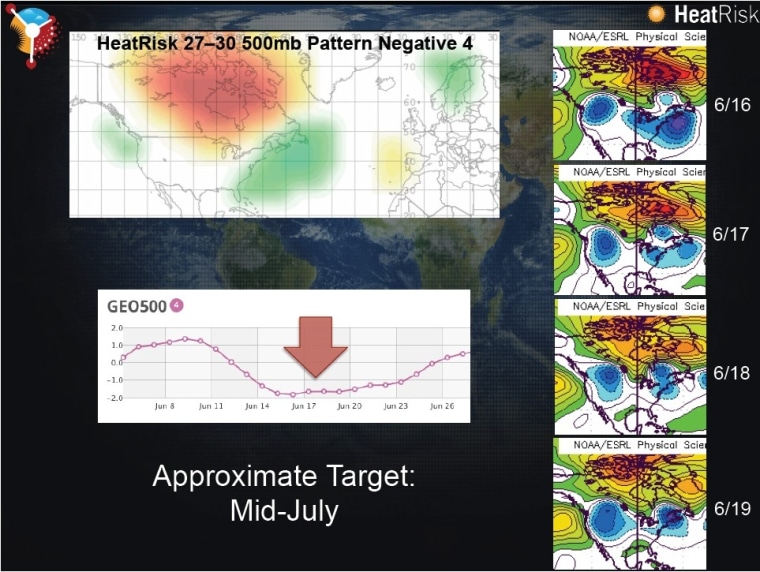OK, so you might not want to know 40 days in advance if a heat wave, or cold snap, is coming — especially if you're going to be stuck in it. But knowing there's a good chance of that happening is worth lots to energy companies, governments and even investors.
Assisted by University of California researchers, a private weather forecasting company called EarthRisk Technologies has developed a software tool it says can do just that, though access to it isn't cheap.
The late July heat wave over much of the U.S.? That was forecast 30 days earlier, says EarthRisk founder Stephen Bennett. Anything coming up? The tool has also spotted some patterns that signal a higher probability for a new East Coast heat wave in mid- to late August.
To put this in perspective, the National Weather Service only forecasts such events out to two weeks. It has more general outlooks for several months ahead, but "there's a gap in weeks three and four" when it comes to hard forecasts, says Mike Halpert, deputy director of the service's Climate Prediction Center.
EarthRisk's recipe boils down to analyzing six decades of publicly available weather data, looking back to see what mix of factors led to past heat waves or cold spikes. That's then used to forecast for broad regions and not specific cities, which would be much tougher job.
Bennett recalls being warned by investors that using past data could be reckless, based on how financial markets perform. "That's true in markets, but not true in weather" since the later has physical boundaries, he says. "You don't have that irrational behavior" of markets.
The genesis goes back three years when Bennett, then working at the U.C.'s Scripps Institution of Oceanography, led a project sponsored by private parties seeking longer-range forecasts for extreme weather.
The scientists' role was to come up with a new way to statistically analyze all that data.
The result, says Scripps researcher Alexander Gershunov, is that "we identified atmospheric circulation patterns that are precursors to very extreme events."
In the July heat wave, for example, one heat wave pattern identified by historical data was "high pressure over Northern Europe," says Kristen Guirguis, a Scripps atmospheric scientist and EarthRisk's chief science consultant. "That had a statistically significant relationship with the heat wave in the Midwest and East."

Other precursors looked at by the tool include jet stream position, air temperature and thunderstorm activity.
Bennett refers to these precursors as "a domino effect" — the more dominoes in place, the better the forecast and the longer out the tool, dubbed HeatRisk, can look.
For a given forecast, "the likelihood is based on how often in the past those precursors actually resulted in a heat wave," adds Gershunov.
The CPC's Halpert says a key test of the product will be how often it gets it right.
"We have seen some signals not pan out as well as we would have liked, but nothing regularly false," responds EarthRisk CEO John Plavan. "Nothing is 100 percent, given the chaotic nature of the atmosphere itself, but the tool’s signals have dramatically better success than anything else available in the 12-40 day range."
EarthRisk is continuing to refine the product, he adds, "so the tool will continue to give better and better signals of long-range events forecasted."
As for the cost, subscriptions for the broader weather package (which includes HeatRisk and the related ColdRisk) run from tens of thousands of dollars to more than $100,000 a year, says Bennett.
EarthRisk says it is open to sharing its approach with public agencies.
"We would welcome the opportunity to work with NOAA and the National Weather Service on methodologies for incorporating this type of work into what they do," says Bennett.
Over at the Climate Prediction Center, Halpert says longer forecasts can save billions by providing time to prepare for a weather disaster.
But he adds that the "further out you go, the less accurate you are."
The CPC has been looking to extend forecasts, he adds, but "we're being stressed just to get the job done that we're doing. It's a very challenging time due to budgets" being cut.
Still, he says of EarthRisk's product, "if there's really something there, we'll look at it."
